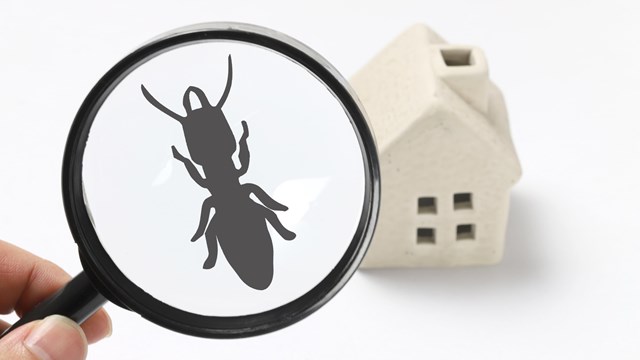Whether interior or exterior, well-built, properly-maintained woodwork can last for centuries—but if wood-boring pests like beetles, termites, and carpenter ants find their way into the wood, they can wreak all kinds of havoc. Wood-destroying insects are more than a nuisance; they are dangerous and can cause significant, costly damage to the structure of a home, condo or co-op. They can also cost a small fortune to eradicate.
Wood You Rather
According to Andy Carace, the owner of Pest-End Exterminators in Plaistow, New Hampshire, “When technicians are inspecting they are looking for ants, termites; we are looking for different things, but most of the time you are looking for moisture. Quite often people see the ants in the kitchen and the problem is they have a sliding door leading out to a deck. What happens is the rain runs off the roof, hits the deck, and splashes onto the slider of the sliding door. They tend to stay moist, so it’s one of the big areas that might need to be replaced.
“At the front door,” he adds, “water will run off the roof and onto the top step and ants will go there. Trees touching the house are also a problem; ants will cross over from them and into your home, looking for food and moisture.”
Louis Taranto, owner of Tonto Pest Control in Brooklyn, New York, echoes Carace, adding that wood-destroying insects often enter buildings searching for food, but often hitch a ride inside wood products brought into the home.
And oftentimes, you don’t even see them until the damage is being done. “Wood-destroying insects will damage wood while feeding on it, or creating tunnels and nesting areas in it,” he says. “They are generally very secluded, spending most of their time inside the wood they are invading.” The telltale signs of wood pest infestation include tiny pinholes visible on wooden surfaces, or even little piles of sawdust collecting under a wooden frame, art object, or piece of furniture—the debris left over from the critters’ chewing and tunneling.
An Insect Primer
According to Michael Bentley, staff entomologist for the National Pest Management Association (NPMA), “Termites and wood-destroying beetles are the most economically important wood-destroying pests that infest homes (including co-ops and condos) in the U.S.” Of the two, it’s termites that are the most problematic and economically important —and the pests are found in every state in the union but Alaska.
“Wood-destroying beetles are more widely distributed than termites, occurring in every state,” Bentley says. “However, they come second to termites in terms of economic importance. Termites are classified into three groups: subterranean, drywood, and dampwood, based upon their nesting preferences. Subterranean termites are the most widespread and costly group. For termites, adults and immatures are responsible for feeding damage to wooden structures, while the larvae of wood-destroying beetles cause the most damage to lumber.” Both insect groups can inflict damage to homes year round. But adults are usually most visible or active during the spring.
However, Carace says, in New England the big issue is carpenter ants. “Carpenter ants are the most common wood damaging pests in the New England area. There not seasonal; they tend to wake up in the spring but then they seem to go away because they turn nocturnal. By the time the summer starts they are working at night, so you see them during the day but you don’t really see the activity that’s going on. Wherever there is moisture in the wood, that’s where they are going to be.”
And according to Bentley, some species of subterranean termite and several important species of wood-destroying beetle aren’t homegrown hassles—they were unintentionally introduced into the United States as invasive species, hitchhiking from other countries on solid wood packing materials, such as freight pallets or in ships’ dunnage.
“Non-native termites and wood-destroying beetles have originated from both tropical and temperate habitats,” he says. “Many of the most costly non-native termite species, including the Formosan and the Asian subterranean termite, originated from various countries in Asia.”
In New England, the Asian Longhorn Beetle has been causing quite a bit of trouble.“The Asian longhorn beetle is eating a lot of the trees in southern New Hampshire. That’s why you can’t bring firewood up into the mountains, for example. They were introduced about a decade ago and make pockets in southern New Hampshire. The state is monitoring them to keep track of the population and to determine if it’s spreading,” says Carace.
So far though, according to Carace, the Asian Longhorn Beetle is only around in limited pockets.
Working with Buildings
For most of the U.S., pest issues tend to be seasonal, increasing in severity as temperatures rise and rainfall increases. These favorable weather patterns typically occur around early/mid-Spring. However, the Southeastern states (Florida in particular) tend to sustain favorable conditions for pests nearly year round. To address these fluctuations, most buildings and HOAs work on a monthly service agreement with their pest control contractor, and when the exterminators arrive at the property, they are given a list of which shareholders or unit owners have problems.
Taranto says that it’s important that every resident in the building understands the importance of looking for signs of wood-damaging insects and not to let even a mild infestation go unchecked.
“If someone notices a problem, they need to act on it and not wait, because this could not only cause more damage to their home, but to the other residents and the building itself,” he says. “They should call whoever is in charge of that in the building so we get notified.”
Carace says, “What they [building managers] need to do is make sure the buildings have good maintenance around them. You can’t have trees brushing against the roof line, you can’t have an old roof that leaks, windows that aren’t tight, decks that are falling apart—that’s going to produce a spongy water effect with the wood, and ants and termites will be drawn to it.”
He adds that residents should “put their food away and stuff, but there’s not a whole lot they can do to prevent ants and termites.”
Top Tips
Bentley encourages boards, managers, and residents alike to take a few simple steps to eliminate conditions that make a property attractive to wood-destroying insects. He says the best way to prevent problems with wood-destroying insects is to make sure that any water-damaged wood in your building or unit is replaced promptly, and that any wood used in your home or in structures around your property is stained or painted, since raw, untreated wood is far more vulnerable to pest infiltration than its varnished, painted, or stained counterpart.
Here are the NPMA’s top tips to help prevent a termite infestation:
Keep basements, attics and crawl spaces well ventilated and dry.
Repair leaking faucets, water pipes and AC units on the outside of the home or building.
Repair fascia and soffits and rotted roof shingles promptly and properly.
Replace weather stripping and repair loose mortar around basement foundations and windows.
Direct water away from your home or building through properly-functioning downspouts, gutters and splash blocks.
“Termites are highly attracted to moisture, so any possible moisture sources such as leaky pipes, improperly sealed windows/doors, and poor exterior drainage should be corrected immediately,” Bentley says. “Additionally, preventing any structural lumber from making contact with soil is another effective way to prevent termites from feasting on your home.”
It is more difficult to prevent wood-destroying beetles from infesting structural lumber. However, an effective strategy for deterring both termites and wood destroying beetles is keeping firewood or other cellulose (yard waste, branches, stumps) off of the ground and stored away from the building.
Carace adds that if you are going to hire an exterminator, you should be sure the company is properly licensed.
“Each state requires that you have a pesticide applicator’s license. In Massachusetts and New Hampshire, I happen to be certified and have a supervisory license; to run a company you need those credentials. There’s a lot of training that goes on. You have to recertify regularly to learn about new safety regulations and new pest control methods,” he says.
Safe Products
Unlike decades ago, the modern options available to pest professionals for managing wood-damaging insects troubling your co-op or condo are registered with the Environmental Protection Agency (EPA), meaning they have been tested and are considered safe for people, pets, and the environment.
For example, according to Taranto, new termite control options that have come about in the last 15-20 years include termite baiting, a treatment that exploits the constant foraging behavior of termites to transport the active ingredient back to the nest where they share the poisoned bait with their fellow nest-mates, thus eradicating the colony. Another option is a wood-applied borate treatment that is most commonly applied to raw lumber before it’s even incorporated into a construction project.
“In most cases a lot of these fly-by-night remedies don’t work. What they may do is push the problem away to another spot, but won’t necessarily get rid of the problem. We tend to use more baits, things they’ll eat at different times of the year. That tends to kill off the problem without applying much pesticide,” says Carace.
He continues, “They’ll come out, feed on it, bring it back to the colony, and they feed the rest of them and kill the rest. But what you really need to do is kill the queen—whether it’s ants or termites, you need to kill the queen.”
Carace adds though, that it’s not just throwing some bait around. There are other methods to use.
“It’s not that all you do is go out there and slap a little bait down and that’s it. You can spray, you can dust—which is injecting dust into a wall where they live to kill them off—there’s also something called microinjection where you’d inject a fog into a wall to draw them out and kill them off,” he says.
Things are starting to change though, according to Carace, “A lot of these pesticides are getting phased out, which is why people are getting more into baiting, due to safety reasons.”
Regardless of whether they’re just a nuisance (like kitchen ants) or a potentially costly threat (like termites), nobody wants bugs in their building. And while a certain amount of pest-related trouble is inevitable in any environment, by staying vigilant for the signs of trouble and removing as many risk-factors as possible from your property, you may be able to avoid having your woodwork chewed into sawdust by these strong-jawed invaders.
Keith Loria is a freelance writer and a frequent contributor to New England Condominium and other publications.







Leave a Comment